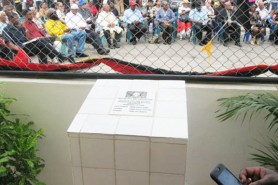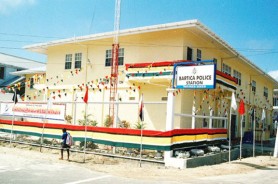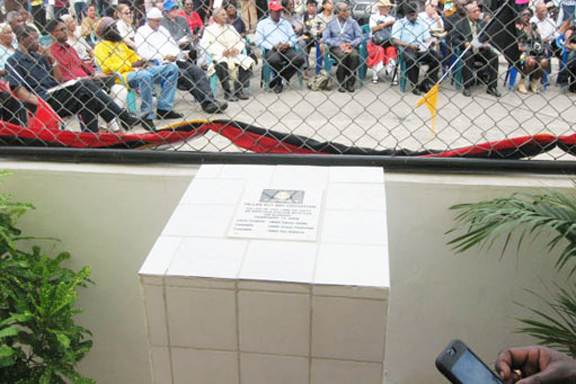Bartica is much more than the ‘gateway to the hinterland.’ It has also become a gold-plated magnet for armed robbery and murder.
Poor David Ramnarine! Promoted to the rank of Assistant Commis-sioner nine months ago at age 40, he was handed the Guyana Police Force’s largest and most problematic division – the ungainly amalgamated E&F Division – with the least manpower and resources. Working from flimsy headquarters in Kingston, Georgetown, he is way outside his area of responsibility unlike other divisional commanders. Over 30 police stations and six outposts, comprising more than one third of the Force’s stations, come under the division.
Mr Ramnarine should be living and working in Bartica – the administrative centre of the Cuyuni-Mazaruni Region – where he can keep an eye on what is happening in the hinterland. The 160-year-old town is the most important centre west of the Essequibo. It has a population of about 15, 000 residents, has been designated a ‘port of entry’, attracts a significant foreign presence and enjoys an expanding social and physical infrastructure.

The hinterland has serious security problems and Bartica is in the thick of things. Chairman of the Cuyuni-Mazaruni Region Mr Holbert Knights only last month expressed his concern that the Police Force’s detachment at Bartica was “handicapped” by the lack of transportation to respond promptly to incidents in the region’s gold- and diamond-mining districts. Knights noted correctly that the Force’s “one boat and one vehicle cannot effectively fight crime in the community.” He felt the number of policemen at the Bartica station in the town was inadequate to cover the township and its environs. He was alarmed at the urge in criminal violence and told the Stabroek News newspaper that many of the violent incidents could be avoided if there was a greater police presence in the hinterland.
President of the Guyana Gold and Diamond Mining Association Frederick Mc Wilfred told the press that “criminals feel they can operate at will” because of a perception that the police could not respond quickly because of staff shortages and lack of resources.
Fear of criminal violence is evident. The murders of 5th Septem-ber 2010 served to remind residents of the 17th February 2008 ‘Bartica Massacre’ when the town was attacked by a heavily-armed gang. On that occasion, the bandits overran the Bartica Police Station, robbed several business places and killed twelve persons, including three policemen, during the hour-long raid.
The bandits’ main target was gold. After neutralising the Police Station, they moved to the CB&R Mining Enterprise owned by Chunilall ‘Vulture’ Babulall. They kicked the door open, shot up the security cameras, executed the guard and took away two safes – one said to contain over $4 million in cash and the other one containing 11 weapons. The bandits then went to the premises of Gurudat ‘Mangoman’ Singh – another gold dealer. After firing several shots at the home, the men entered the yard using a large sledge hammer, smashed open the vent blocks of a concrete wall, broke into the house and ransacked it.

The gruesome murders of two large-scale gold dealers – Ramdeo ‘Prakash’ Deonarine and Jainarine ‘Jai’ Raghubir – on 5th September confirmed Holbert Knights’s worst fears about the virulence of criminal violence. The men’s bodies with their throats slit were found in a house which is owned by businessman Ricky Ramnarine of CB&R Mining – the same company that was targetted in the 2008 Massacre. The two-storeyed house was well grilled and equipped with CCTV cameras but reports suggest that the surveillance cameras had been disabled. The bandits stole raw gold, diamonds and cash – reportedly valued at $100 M and owned by Deonarine and Ramnarine – and their victims’ personal firearms before escaping. Cash and other items belonging to Ramnarine were also stolen.
Commissioner of Police Mr Henry Greene, even before the recent murders,
had told the press that the high price of gold was the biggest lure of criminals to the hinterland. He said “… the price of gold is very high and I think that is really what [is] captivating people to move into the interior and some criminal elements end up in there.” Frederick Mc Wilfred also noted that criminals had been attracted to the mining areas is because of the rising price of gold which he said was about the equivalent of G$ 220,000 per ounce on the international market.
Whether in pursuit of gold or not, criminals have been active and there have been several signs of a rising level crime over the past two years in Bartica. Some non-fatal armed robberies targetted Brazi-lian businessman and known gold-dealers in the town who were shot and robbed of raw gold and cash. After a spate of gun crimes in the township, the Police had mounted a special hunting expedition in February 2009 in which three suspects – Dwayne ‘Bully’ Marks, Antwan ‘Deportee’ Singh and Gavin ‘Sweet Eyes’ Gray – were all shot dead at Arimu in the Cuyuni. The Police had identified Marks as the mastermind behind criminal attacks in Bartica that led to Holbert Knights’s call for increased and active law enforcement in the town.
The robbery and murder of Dweive Kant Ramdass – another Bartica gold dealer – by members of the Guyana Defence Force Coast Guard on 20-22 August 2009 in the Essequibo River was also part of the pattern of criminality. It is clear that persons connected to Bartica’s rich gold community have been known to possess huge amounts of raw gold and cash and, as a result, had been targeted for robbery or worse. Bartica is the hub of gold-mining in the Cuyuni-Mazaruni and Potaro-Siparuni Regions and, as more profits are garnered from the goldfields, more attacks can be anticipated.
The pattern of murders is unmistakable. Over the past two months, Allan Welch, was beaten to death at Issano on 6th July; John Philander was hacked to death at Echerak in the Potaro on 16th July; Rawle Mentore was killed at Takuba Trail, Kurupung on 20th August; Charles Garraway, a businessman of Bartica, died on 22nd August two days after a miner doused him with gasoline and set him afire; Sylvester Simon was killed at Apaikwa Landing, Maza-runi on 29th August; Vincent Williams was killed at Issano on 31st August and Mervin Andrews was beaten to death at Tamakay Landing, Mazaruni, on 2nd September.
There have been lots of meetings between administration officials and the Bartica community. When President Bharrat Jagdeo visited on 21st July 2005, the Bartica Chamber of Commerce called for repairs to the existing aerodrome and its access roads. These could serve as a vital accessories for both security and the local economy. They requested also that the road from Parika to Makouria be built to facilitate the easier transport of goods, vehicles and passengers to and from Bartica.
The President agreed that the aerodrome should be upgraded but noted that the Government was unable to do so owing to lack of resources. “That airstrip would have to be done at some point in time. I agree with you, but it can’t be in the budget for this year… most likely in next year’s budget we can put in the repairs of the airstrip and the roads.” That was five years ago. Priority attention seems to have shifted to constructing a new airstrip at Wakenaam Island in the Essequibo River estuary even as many residents there said that one was not needed.
There has been no shortage of meetings to discuss the hinterland security situation. President Bharrat Jagdeo, accompanied by the then Minister of Home Affairs Ms Gail Teixeira and Commissioner of Police Winston Felix, met executives of the Guyana Gold and Diamond Miners’ Association to discuss hinterland security four and a half years ago in January 2006. Following the ‘Bartica Massacre,’ even more meetings were held with the Minister of Home Affairs, the Prime Minister and senior security forces officers. Following the ‘Lindo Creek Massacre,’ the Guyana Geology and Mines Commission and the Guyana Gold and Diamond Miners’ Association held more meetings to complain about the state of security in the hinterland where mining takes place.
The meeting between the Minister of Home Affairs and stakeholders from the Private Sector Commission most recently on 25th August 2010 had as its most promising outcome nothing weightier than a decision to examine “The possibility of establishing more check points in interior regions” by the Police Force in consultation with the Guyana Forest Products Association and the Guyana Gold and Diamond Miners’ Association. This cannot be good enough in this age of hinterland insecurity. More meetings will not solve the policing problem.
Bartica’s security problems are rooted in the failure of the Ministry of Home Affairs and the Guyana Police Force to comprehend the scale and scope of the hinterland security problem as a whole. Bartica sits at the centre of the country’s most egregious public security absurdity – the Police Force’s ‘E&F’ Divisions which together combine five of the largest administrative regions and which comprise approximately 70 per cent of this country’s territory.
This single police division − starting at Dora on the Soesdyke-Linden Highway − stretches beyond Achewib in the South, Kaikan in the West and Morawhanna in the North. It is responsible for over 1,800 km of land borders with Brazil and Venezuela. Vast expanses of open spaces, unmonitored airstrips and numberless rivers serve as corridors for illegal narcotics and firearms to be carried to commit crimes on the coastland. It has been an error to underestimate the spatial dimension of national security.
The Police Force has never been given sufficient personnel and other resources to effectively enforce the law in widely dispersed villages, mining camps and timber grants. Robbery with violence, as a result, has been a frequent occurrence and it is easy for assailants to escape. Recent statistics indicate that 21 per cent of all murders in the country so far in 2010 have occurred in the E&F mega-division.
The Minister of Home Affairs and the Police Force must re-appraise the old divisional structure, recruit the constables needed to bring the Police Force up to its authorised establishment, retrain policemen to operate in the ‘bush,’ acquire more river boats, reconsider the location of police stations and the improve the provision of communication, transportation, and investigation equipment to the Force.
The administration, although it was warned of the dangerous trend in armed robberies several years ago, seems to be clueless about how it should respond to the surge in criminal violence. On the very morning that Bartica was reeling from the revelations of these latest atrocities on 5th September, Minister of Home Affairs Mr Clement Rohee was carrying forward his campaign to a retreat of 29 Community Policing Groups at Chateau Margot on the East Coast Demerara. The Minister has been busily pursuing his favourite Community Policing Groups, Neighbourhood Police and Citizens Security Programme while vulnerable communities such as Bartica are helpless against violent crime.
There needs to be new thinking at the ministerial level to protect the people who live and work in Bartica and its environs.





